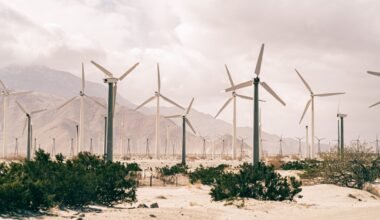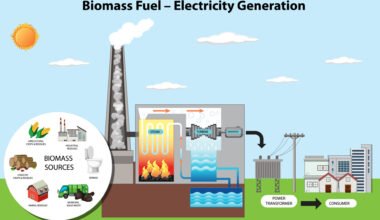Renewable energy is a topic that has been gaining attention over the last few years. As the world becomes more conscious of the impact of carbon emissions on the environment, the need for low-carbon electricity has become more pressing.
In this article, we will explore the different types of low-carbon electricity, their advantages and disadvantages, and the challenges associated with transitioning to low-carbon electricity.

Definition of Low-Carbon Electricity
Low-carbon electricity refers to electricity that has a low carbon footprint, meaning it emits fewer greenhouse gases into the atmosphere. This type of electricity is generated using renewable energy sources, such as wind, solar, hydro or nuclear power, that have lower carbon emissions. Low-carbon electricity is a key component in the fight against climate change, as it reduces the amount of carbon dioxide released into the atmosphere.

Importance of Low-Carbon Electricity
Low-carbon electricity is important for several reasons. Firstly, it is environmentally friendly, as it releases fewer greenhouse gases into the atmosphere. This helps to slow down the pace of climate change and reduce the impact of global warming.
Secondly, low-carbon electricity is a more sustainable energy source than fossil fuels, as it can be replenished naturally. This makes it a more reliable source of energy in the long term.
Finally, low-carbon electricity is becoming increasingly affordable as technology advances. This is making it a more attractive option for both consumers and businesses, as it can help to reduce energy costs.
Types of Low-Carbon Electricity
There are four main types of low-carbon electricity: wind power, solar power, hydroelectric power, and nuclear power. Let’s take a closer look at each of these.
Wind Power
- Wind power is the conversion of wind energy into electricity. It is a renewable source of energy that is becoming increasingly popular around the world. In fact, wind power is one of the fastest-growing sources of electricity generation.
- How Wind Power Works
- Wind turbines are used to generate wind power. These turbines consist of blades that rotate when they are hit by wind. The rotation of the blades drives a generator, which produces electricity.
- Advantages and Disadvantages of Wind Power
- One of the main advantages of wind power is that it is a clean and renewable source of energy. It produces no greenhouse gases and has a low carbon footprint.
- Another advantage of wind power is that it is becoming increasingly affordable. As the technology improves, the cost of wind power is coming down, making it more accessible for consumers and businesses.
- However, there are also some disadvantages to wind power. One of the main disadvantages is that wind turbines can be noisy and unsightly, which can be a concern for people who live near them.
Solar Power
- Solar power is the conversion of sunlight into electricity. It is a renewable source of energy that is becoming increasingly popular around the world. In fact, solar power is the fastest-growing source of electricity generation.
- How Solar Power Works
- Solar panels are used to generate solar power. These panels consist of photovoltaic cells that convert sunlight into electricity. When sunlight hits the cells, it creates an electric field that generates a flow of electricity.
- Advantages and Disadvantages of Solar Power
- One of the main advantages of solar power is that it is a clean and renewable source of energy. It produces no greenhouse gases and has a low carbon footprint.
- Another advantage of solar power is that it can be used in remote areas where there is no access to the grid. This makes it a useful source of energy for off-grid communities.
- However, there are also some disadvantages to solar power. One of the main disadvantages is that it is expensive to install. The cost of solar panels has been coming down, but it is still more expensive than other types of electricity generation.
Hydroelectric Power
- Hydroelectric power is the conversion of energy from flowing water into electricity. It is a renewable source of energy that has been used for many years.
- How Hydroelectric Power Works
- Hydroelectric power is generated by dams that are built across rivers. The water that flows through the dam drives turbines, which produce electricity.
- Advantages and Disadvantages of Hydroelectric Power
- One of the main advantages of hydroelectric power is that it is a clean and renewable source of energy. It produces no greenhouse gases and has a low carbon footprint.
- Another advantage of hydroelectric power is that it is reliable. It can be used to generate electricity continuously, unlike other types of renewable energy sources that rely on weather conditions.
- However, there are also some disadvantages to hydroelectric power. One of the main disadvantages is that it can have negative environmental impacts. The construction of dams can disrupt ecosystems and displace communities.
Nuclear Power
- Nuclear power is the conversion of nuclear energy into electricity. It is a controversial source of energy that has both supporters and opponents.
- How Nuclear Power Works
- Nuclear power is generated by nuclear reactors that use uranium to produce steam. The steam drives turbines, which produce electricity.
- Advantages and Disadvantages of Nuclear Power
- One of the main advantages of nuclear power is that it is a low-carbon source of energy. It produces fewer greenhouse gases than fossil fuels.
- Another advantage of nuclear power is that it is reliable. It can be used to generate electricity continuously, unlike other types of renewable energy sources that rely on weather conditions.
- However, there are also some disadvantages to nuclear power. One of the main disadvantages is that it produces radioactive waste, which is difficult to dispose of safely. There is also a risk of accidents, which can have catastrophic consequences.
Pros and Cons of Low-Carbon Electricity
Low-carbon electricity is at the forefront of the sustainable energy revolution, offering a cleaner and more environmentally friendly alternative to traditional fossil fuels. However, like any energy source, it comes with its own set of advantages and challenges. In this section, we’ll take a closer look at the pros and cons of low-carbon electricity to help you gain a comprehensive understanding of its implications.
- Environmental Benefits: One of the most significant advantages of low-carbon electricity is its positive impact on the environment. It produces significantly fewer greenhouse gas emissions compared to conventional fossil fuels, which helps mitigate climate change and reduce air pollution. By utilizing renewable sources like wind, solar, and hydropower, low-carbon electricity contributes to a cleaner, healthier planet.
- Reliability and Resilience: Low-carbon electricity sources, especially renewables, are known for their reliability and resilience. Unlike fossil fuels, which can be subject to price fluctuations and supply disruptions, renewable energy sources are often abundant and consistent. This reliability enhances energy security and reduces the vulnerability of the energy grid to external factors.
- Cost and Affordability: While low-carbon electricity offers long-term cost savings through reduced fuel costs and maintenance, the initial investment in renewable energy infrastructure can be substantial. Solar panels, wind turbines, and hydropower facilities require capital upfront. However, as technology advances and economies of scale are realized, the cost of renewable energy systems is steadily decreasing, making them more accessible and affordable over time.
- Intermittency and Energy Storage: A potential drawback of some low-carbon electricity sources, such as solar and wind, is intermittency. These sources depend on weather conditions, leading to fluctuations in energy production. To address this issue, advancements in energy storage technologies, such as batteries, are improving the ability to store excess energy during periods of high production and release it when needed, thereby mitigating the impact of intermittency.
As technology and infrastructure continue to evolve, the benefits of low-carbon electricity are expected to outweigh its drawbacks, making it a crucial component of a cleaner, greener energy landscape.
Transition to Low-Carbon Electricity
Transitioning to low-carbon electricity is not without its challenges. In this section, we will explore the challenges associated with transitioning to low-carbon electricity and the role of government policy in promoting low-carbon electricity.
Challenges Associated with Transitioning to Low-Carbon Electricity
- One of the main challenges associated with transitioning to low-carbon electricity is the need for infrastructure upgrades. For example, upgrading the grid to handle renewable energy sources can be expensive and time-consuming.
- Another challenge is changing consumer behavior. Consumers need to be educated about the benefits of low-carbon electricity and encouraged to make the switch.
Government Policy
- Government policy plays an important role in promoting low-carbon electricity. In this section, we will explore two ways that government policy can promote low-carbon electricity: incentives for renewable energy development and carbon pricing.
- Promoting Low-Carbon Electricity
- One way that the government can promote low-carbon electricity is by providing incentives for renewable energy development. For example, the government could offer tax breaks or subsidies for companies that invest in renewable energy.
- Another way that the government can promote low-carbon electricity is by setting renewable energy targets. For example, the government could set a target for 50% of electricity to come from renewable sources by 2030.
- Carbon Pricing
- This is another way that the government can promote low-carbon electricity. Carbon pricing is a policy that puts a price on carbon emissions. This makes it more expensive for companies to emit greenhouse gases, which encourages them to switch to low-carbon alternatives.
Future of Low-Carbon Electricity
The future of low-carbon electricity looks bright. In this section, we will explore emerging technologies and innovations in low-carbon electricity and the potential for further reduction of carbon emissions.
Emerging Technologies and Innovations
- There are many emerging technologies and innovations in low-carbon electricity. For example, some companies are researching ways to store energy from renewable sources so that it can be used when the wind isn’t blowing or the sun isn’t shining.
- Another emerging technology is the use of smart grids. Smart grids use sensors and other technology to better manage the distribution of electricity, making it more efficient and reducing the need for fossil fuels.
Further Reduction of Carbon Emissions
- As technology improves and more people switch to low-carbon electricity, there is potential for even further reduction of carbon emissions. For example, some experts predict that the world could be powered entirely by renewable energy by 2050.
Case Studies
There are many countries and companies that have successfully transitioned to low-carbon electricity. In this section, we will explore some case studies.
Countries That Have Successfully Transitioned to Low-Carbon Electricity
- One country that has successfully transitioned to low-carbon electricity is Costa Rica. In 2017, Costa Rica generated 99% of its electricity from renewable sources, including hydroelectric, wind, solar, and geothermal power.
- Another country that has successfully transitioned to low-carbon electricity is Sweden. In 2018, Sweden generated 54.6% of its electricity from renewable sources, including hydroelectric, wind, and solar power.
Companies That Have Successfully Transitioned to Low-Carbon Electricity
- One company that has successfully transitioned to low-carbon electricity is Google. In 2017, Google announced that it had achieved its goal of being 100% powered by renewable energy.
- Another company that has successfully transitioned to low-carbon electricity is IKEA. In 2018, IKEA generated more renewable energy than it consumed, making it a net energy exporter.
Impact on Climate Change
Low-carbon electricity has an important role to play in mitigating climate change. In this section, we will explore the importance of low-carbon electricity in mitigating climate change and reducing greenhouse gas emissions.
Importance of Low-Carbon Electricity in Mitigating Climate Change
- Low-carbon electricity is a key component in the fight against climate change. By reducing greenhouse gas emissions, low-carbon electricity helps to slow down the pace of climate change and reduce the impact of global warming.
Reducing Greenhouse Gas Emissions
- Low-carbon electricity is an effective way to reduce greenhouse gas emissions. For example, replacing coal-fired power plants with low-carbon alternatives can significantly reduce greenhouse gas emissions.
Consumer Choices
Consumers can also play a role in promoting low-carbon electricity. In this section, we will explore two ways that consumers can support low-carbon electricity: choosing renewable energy providers and investing in solar panels.
Choosing Renewable Energy Providers
- Consumers can choose to purchase electricity from renewable energy providers. This sends a signal to energy companies that there is a demand for low-carbon electricity.
Investing in Solar Panels
- Consumers can also invest in solar panels to generate their own electricity. This can help to reduce energy costs and reduce greenhouse gas emissions.
Conclusion
Low-carbon electricity is an important part of the fight against climate change. By reducing greenhouse gas emissions, low-carbon electricity helps to slow down the pace of climate change and reduce the impact of global warming. While there are challenges associated with transitioning to low-carbon electricity, emerging technologies and innovations are making it increasingly accessible and affordable.
As individuals, we can also play a role in promoting low-carbon electricity by choosing renewable energy providers and investing in solar panels. Let’s work together to support low-carbon electricity and combat climate change.
References:








